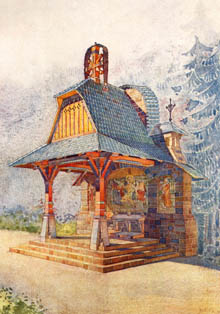
Slovak architect Jurkovič - "poet of wood"
 |
When looking at Jurkovič's wooden constructions in Pustevny (1897 to 1899), it is clear that the then not-yet-thirty-year-old architect already had a firm grasp of Wallachian folk architecture. Each cottage (for example, the Maměnka hotel or the Libušín restaurant) is different in its colors and motifs of carvings, making each unique. Jurkovič's distinctive buildings on Radhošť generated great interest at the time, earning him the title "the poet of wood." These national cultural monuments, in their new-old guise, are still a major draw today, not just for tourists.
The versatile architect and ethnographer was later offered the task of creating a concept for the spa that was being developed in Luhačovice. Jurkovič began with the expansion of the square and the reconstruction of older buildings, especially by connecting adapted structures into a new and extensive so-called Jan's house (currently under reconstruction as Jurkovič’s house). This was followed by the reconstruction of Chaloupka and the Water Treatment Institute, as well as the construction of other houses, such as the Jestřabí villa (later Janáček's house) or the Slovácká búda, which tragically burned down in 2002.
Other projects by Jurkovič include the Stations of the Cross in Svatý Hostýn, the Civic Savings Bank building in Vsetín, residential rental houses in Brno, the Peklo restaurant in Nové Město nad Metují, and a family house in Prague-Bubeneč. The architect is also the author of the monumental tomb and mausoleum of Milan Rastislav Štefánik on Bradlo. However, less is known about his involvement in the construction of military cemeteries in western Galicia. One of his unrealized projects was the idea of building prefabricated wooden houses.
Jurkovič was born on August 23, 1868, in the Slovak village of Turá Lúka into the family of a national awakener and a notary. He was educated in Slovak and Austrian schools. He developed his passion for folk architecture as an independent architect in the construction office of Michal Urbánek in Vsetín. Urbánek later sent him to the Czechoslovak Ethnographic Exhibition in Prague (1895) with a successful project for a Wallachian village. Here, Jurkovič established contacts with Mikoláš Alš and Joža Úprka, with whom he later collaborated.
In 1899, he settled in Brno, where he found his lifelong partner - Božena Bartelmusová, the daughter of a factory owner. The Jurkovičs also had three sons in the Moravian metropolis. In the Žabovřesky district, they built a family villa (1906). The outer wall plates of this significant building are cork and were plastered with cement, while the interior was plastered with gypsum. The concept of Jurkovič's house is based
The English translation is powered by AI tool. Switch to Czech to view the original text source.
0 comments
add comment
Related articles
0
27.08.2024 | The Zlín Gallery has acquired the exhibition version of the Köhler Stations of the Cross mosaic
0
07.03.2014 | Experts ensure the stability of the burned Libušín in Pustevny
0
03.03.2014 | At Pustevny, the Libušín lodge was burning, a third alarm level was in effect
0
12.03.2011 | Dušan Jurkovič - architectural work












